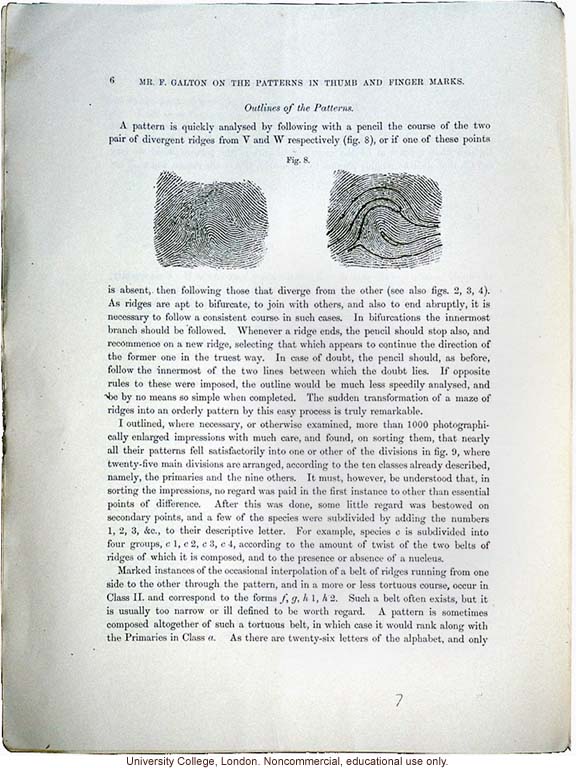6 Mr. F. Galton on the Patterns in Thumb and Finger Marks.
[Italics]Outlines of the Patterns[end italics]
A pattern is quickly analysed by following with a pencil the two pair of divergent ridges from V and W respectively (fig.8), or if one of these points
[illustration Fig. 8]
is absent, then following those that diverge from the other (see also figs. 2, 3, 4). As ridges are apt to bifurcate, to join with others, and also to end abruptly, it is necessary to follow a consistent course in such cases. In bifurcations the innermost branch should be followed. Whenever a ridge ends, the pencil should stop also, and recommence on a new ridge, selecting that which appears to continue the direction of the former one in the truest way. In case of doubt, the pencil should, as before, follow the innermost of the two lines between which the doubt lies. If opposite rules to these were imposed, the outline would be much less speedily analysed, and be by no means so simple when completed. The sudden transformation of a maze of ridges into an orderly pattern by this easy process is truly remarkable.
I outlined, where necessary, or otherwise examined, more than 1000 photographically enlarged impressions with much care, and found, on sorting them, that nearly all their patterns fell satisfactorily into one or other of the divisions in fig. 9, where twenty-five main divisions are arranged, according to the ten classes already described, namely, the primaries and the nine others. It must, however, be understood that, in sorting the impressions, no regard was paid in the first instance to other than essential points of difference. After this was done, some little regard was bestowed on secondary points, and a few of the species were subdivided by adding the numbers 1, 2, 3, &c., to their descriptive letter. For example, species [italics]c[end italics] is subdivided into four groups, [italics]c[end italics]1, [italics]c[end italics]2, [italics]c[end italics]3, [italics]c[end italics]4, according to the amount of twist of the two belts of ridges of which it is composed, and to the presence or absence of a nucleus.
Marked instances of the occasional interpolation of a belt of ridges running from one side to the other through the pattern, and in a more or less tortuous course, occur in Class II. and correspond to the forms [italics]f, g, h[end italics]1, [italics]h[end italics]2. Such a belt often exists, but is usually too narrow or ill defined to be worth regard. A pattern is sometimes composed altogether of such a tortuous belt, in which case it would rank along with the Primaries in Class [italics]a. As there are twenty-six letters of the alphabet, and only
[end]


